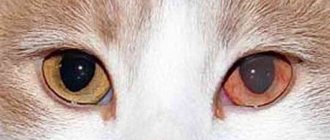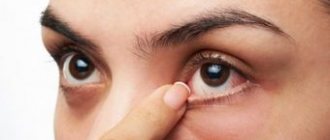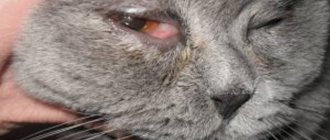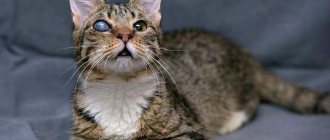If you notice redness in your cat's eyes, he may have experienced an eye injury, an allergy or irritant, a viral infection such as distemper, a bacterial infection, glaucoma, cherry eye, or cancer. Red eye in cats can be a serious medical problem that can worsen over time, causing blindness and further destruction of the orbital structure.
Red eye in cats is a symptom of an underlying medical condition, eye irritation, or eye damage in cats. A red color in one or both eyes indicates that the feline is suffering from an unknown medical condition that should be treated by a licensed veterinarian.
Symptoms of red eyes in cats
A fairly obvious symptom of red eyes in cats is that the eyes are essentially red. Depending on the source of the red eye, the feline may or may not experience the following additional associated symptoms:
- The whites of the eyes turn red
- Swollen eyes
- Swollen eyelids
- Discharge from the eyes (clear, white, yellow, or green)
- Tearing
- Protruding third eyelid (cherry eye)
- Itchy eyes
- Inability to open an eye
- Loss of vision
- Sneezing
- Painful eyes
© shutterstock
How to treat lacrimation at home?
It is important to note that you should not put human medications in your pet's eyes. Firstly, they are ineffective for animals, and secondly, exceeding the dosage can have a detrimental effect on the cat.
As an additional means to the main treatment, you can treat with decoctions of herbs, such as chamomile, sage or calendula. Also, instead of herbs, you can use strong tea leaves or a weak solution of manganese. Such washing helps to get rid of pus in the pet’s eye, stop inflammation, and heal the affected eyeball.
Causes
Cats' eyes can become red for a number of reasons. Injury, allergies, obstructions, structural changes in the eye, disease, viral infections, bacterial infections and irritants can cause a red eye in a cat. The most common causes of red eyes in cats are:
Injury:
- Scratches
- Bites
- Foreign object
- Allergens
- pollen
- Dust
- Bee stings
Annoying:
- Cigarette smoke
- Perfumery
- Air freshener
Obstacles:
- Seedling
- Grass seeds
- Dirt
Structural changes:
- Entropion (eyelid protrudes inward)
- Ectropion (eyelid protrudes outward)
- Distichiasis (abnormal eyelash growth)
Disease:
- Cancer
- Autoimmune disease
Bacterial infection:
- Chlamydia
- Mycoplasma
Viral infections:
- Feline herpesvirus type 1
- Calicivirus
- Feline immunodeficiency virus (FIV)
- Feline leukemia (FeLV)
Types of diseases
Regardless of the reasons, the following diseases develop with signs of redness of the eyes:
- blepharitis;
- conjunctivitis;
- third eyelid adenoma;
- prolapse of the nictitating membrane;
- eversion of the eyelids.
Blepharitis
The disease is often confused with conjunctivitis. However, there is a difference. Blepharitis begins with red, watery, and itchy eyes. The kitten scratches the organs of vision, inflammation of the eyelids leads to their closure. Treatment with drugs that work well for conjunctivitis does not bring relief.
Blepharospasm
Conjunctivitis
Inflammation is caused by micromycetes and bacteria that constantly live on the outer integument of the animal. The immune system prevents the rapid development of secondary microflora. But infectious diseases, external irritants, and intestinal worms weaken the defense, causing inflammation.
Chlamydia causes particular damage to the conjunctiva. These creatures, which occupy an intermediate position between bacteria and viruses, bother kittens from the age of four weeks. First one eye becomes inflamed, then the other. The disease is dangerous for humans; if handled carelessly, it can cause conjunctivitis.
Chlamydia conjunctivitis
Adenoma of the third century
This benign growth, resembling a soybean, is located near the bridge of the nose. Occurs as a consequence of injury or secondary infection. The bulge prevents the eye from closing, which leads to further injury and redness.
Adenoma of the nictitating membrane
The animal refuses food, becomes irritable and aggressive.
Prolapse of the nictitating membrane
Membrane prolapse is not an independent disease, but a symptom of the underlying one. If the disease affects one eye, then it is assumed that a speck or a congenital anomaly has gotten under the third eyelid. Bilateral inflammation is the result of infection of the organs of vision by secondary microflora during viral infections or helminthic infestations. Otherwise, the disease is called cherry eye. The angular seal of the organ of vision resembles a red berry in shape and color.
Eversion of the eyelids
Eyelashes come into contact with the eye sphere, injuring it. The disease causes pain, lacrimation, corneal hyperemia, and blepharospasm. Cats of exotic breeds are predisposed to the disease.
Diagnosis of red eyes in cats
It is very important for pet owners to convey any clinical signs and symptoms they notice at home when they bring a cat with red eyes to the veterinarian. Because red eye in cats can be caused by a long list of potential causes, any information you can provide to your veterinarian will be helpful in making diagnostic differentiation.
The doctor will begin by reviewing the cat's medical history, carefully reviewing past illnesses, medications, and vaccinations. He or she may ask about the environment in which your cat lives, including any possible allergens, irritants, or possible means of injury in the cat's environment.
© shutterstock
- Ophthalmological examination
A physical examination of the eye will be the next step in the veterinarian's diagnostic plan, as the exam will evaluate the eye and all ocular structures. The veterinarian will likely use an ophthalmoscope, which is a light-reflecting instrument that will allow the veterinarian to see the internal structures of the eye.
- Fluorescent spot test
An ophthalmic examination tool that uses blue light and orange dye can be used to detect abnormalities in the eye.
- Schirmer's tear test
Ophthalmic tests use tear strips that are placed on the lower eyelid to assess the level of tear production in cats.
- Tonometry
An ophthalmic test used to evaluate the intraocular pressure of the eye.
- Laboratory tests
The veterinarian may also take a swab of cells or discharge from the eye for microscopic examination. Collected cells may reveal structural abnormalities or bacterial infection. Blood tests, urinalysis, and specialized tests for FeLV or FIV will likely be part of your cat's differential diagnosis.
Protrusion (loss) of the third eyelid gland
Symptoms:
— A red or pink formation appears in the inner corner of one or both eyes.
- Discharge is usually in the form of tears or mucus in small quantities.
Treatment:
1. Surgical, preference is given to repositioning the gland rather than removing it, since this gland accounts for 30 to 50% of the total amount of tears produced.
============================================================================================================================================================================================
What to do
Treatment for red eyes in cats depends on the condition that is causing your cat's eye to appear reddish. If your cat's red eyes are due to allergies or irritants, your veterinarian may recommend a few simple changes at home and prescribe antihistamines.
However, if the cause of your cat's red eyes is a structural abnormality, foreign obstruction, injury, or growth, a surgical procedure may be required to return your cat's eyes to their original state. Chemotherapy drugs and radiation therapy may also be part of your cat's treatment plan if the cause of your cat's red eyes is cancer.
Obstruction of the nasolacrimal duct
Normally, tears should flow out through a special channel that runs inside the nose (nasolacrimal duct), but if this outflow path is disrupted, the tear has nowhere else to flow except outward, to the area near the eyes.
Symptoms:
- Various degrees of lacrimation and brown coloration of the fur around the eyes (formation of “tear tracks”).
This may be a breed predisposition - as congenital pathology is often found in Sphynx, Persian, British, exotic, Scottish and other short-faced cats; or as a consequence of inflammatory processes in the eye area.
Treatment:
1. If the obstruction is associated with overgrowth or blockage of the nasolacrimal duct, then surgical dilation of the canal is possible. 2. But most often, with this problem, it is enough to carry out daily hygienic care using special lotions to remove tear ducts.
===========================================================================================================================================================================================
Prevention of eye diseases
Of course, no cat can be completely immune from diseases of the organs of vision, but it is within the power of a person to do everything to ensure that the risks of such diseases are as small as possible. To do this, it is necessary to provide proper care for your pet’s eyes.
To prevent bacteria from multiplying in the mucus that periodically accumulates in the corners of the cat’s eyes, this mucus must be removed. To do this, you can use special disinfectant eye lotions or herbal decoctions.
When bathing your pet, you need to make sure that the soap solution and water do not get into her eyes and do not irritate them. The same precautions should be taken when treating your furry beauty against fleas and other parasites with insecticidal drops and powders.
If the domestic predator is a long-haired breed, you need to pay attention to the length of the hair above the cat’s eyes. If the hair hangs over, then it can scratch its delicate conjunctiva unnoticed by a person, but extremely noticeably for a cat, injuring them and, as a result, causing redness.
When performing any procedures on a cat’s eyes, the owner needs to be very careful not to scratch or damage the delicate organ of vision. Do not use dry wipes or cotton wool, as their fibers may get into your eyes. It is best to moisten a napkin or cotton wool in a special eye solution intended for cleaning or in a weak chamomile decoction.
Preparing for going to the clinic and treatment
0 Source:
Before going to the doctor, you need to write down or note for yourself exactly when the lacrimation began, which eye began to water first, the nature of the discharge, the animal’s diet in the last few days, treatment, vaccination or surgery in the recent past, the presence of additional symptoms. This will allow the veterinarian to quickly make the correct diagnosis and prescribe effective therapy. Typically, veterinarians prescribe drugs such as furatsilin, chloramphenicol, sofradex and kanamycin, which must be used in accordance with the instructions. To speed up recovery and alleviate the animal’s condition, you can resort to auxiliary therapy, unless, of course, we are talking about a bruise or allergy, and not a serious disease of the visual organs. Eyes can be washed with furatsilin solution, infusion of calendula or chamomile, and even regular black tea. These products have an antibacterial and soothing effect. Gently wipe the eyelid area with a cotton pad soaked in the infusion, remove the crusts and drip the medicine. During manipulations, it is advisable to seek the help of someone close to you. If this is not possible, the animal must be tightly secured, for example, with a scarf. It is important to speak kindly and calmly to the cat during manipulations, so as not to scare the animal, and be sure to reward it with some kind of treat upon completion.
Therapy tactics
Treating an animal at home without conducting a comprehensive diagnosis is strictly prohibited. It is necessary to promptly seek help from a veterinarian .
When the inflammatory process develops, antibiotics and eye ointments and drops are prescribed. If symptoms arise due to the development of another pathology, the underlying disease is treated. Only after this the remaining clinical manifestations are eliminated.
Some diseases respond well to treatment, while others require the use of medications throughout the pet’s life. Sometimes cure is impossible without surgery.
The following medications will help alleviate your pet’s condition:
- Furacilin. Used for the development of conjunctivitis. The affected mucous membranes are washed.
- Levomycetin. Used for bacterial conjunctivitis. The drug is instilled into both eyes.
- Tetracycline ointment. The medication is applied to the visual organs several times during the day.
- A solution based on novocaine, hydrocortisone (injection) helps eliminate pain.
Traditional medicine
Folk remedies will help cope with the problem only in combination with medications. Chamomile decoction is often used. It is prepared in a water bath and filtered. Wash your eyes three times a day.
Also used:
- Manganese solution. Light pink liquid. It is important that all grains are completely dissolved in water, otherwise there is a risk of damage to the mucous membranes.
- A decoction of St. John's wort, calendula, sage. It is used for purulent inflammatory processes. Used as a compress. The procedure is carried out 2-3 times a day.
- Black tea. For washing mucous membranes.











